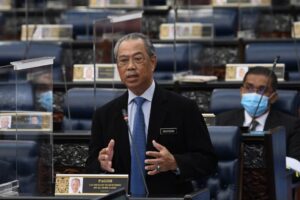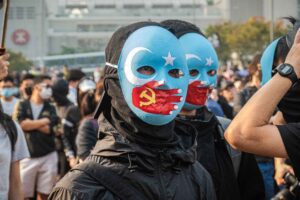
The Muhyiddin Administration granted 5G frequency bands to five Malaysian telecommunications
providers
Source: Atiqah Nazir, Flickr
MIDWAY THROUGH MAY 2020, Malaysian Prime Minister Muhyiddin Yassin’s government quietly, and forgoing the promised public tender process, granted 5G frequency bands to five Malaysian telecommunications providers. These included four of the country’s biggest — Maxis, Celcom, Digi, and Telekom Malaysia (TM) — as well as the obscure Altel.1 Behind Altel is Syed Mokhtar Albukhary, a Malaysian billionaire who has been the subject of much public criticism due to his fistful of government-licensed monopolies, including rice distribution, motor vehicle inspection, postal services, the running of media companies and ports.2 A public uproar in early June caused the government to quickly reverse its decision by revoking the allocations of all providers. Previous promises of a third-quarter rollout of 5G have been delayed until late 2022 or early 2023, buying the Muhyiddin Administration more time to formulate an allocation process that will avoid a public backlash. Instead, it has decided to focus on optimising 4G speed and coverage under the new Jalinan Digital Negara Plan (JENDELA).
The initial plan announced by the Mahathir Administration’s MCMC National 5G Task Force was to offer the pioneer spectrum bands of 700MHz and 3.5GHz to a consortium of firms. This was justified on grounds of efficiency and cost, as forcing providers to work together prevents the duplication of infrastructure and lowers capital expenditure. After Mahathir was ousted, his successor, Muhyiddin, bypassed the previously announced process and allocated the 700MHz spectrum to five providers.
The People’s Republic of China (PRC) appears to be the big winner in Malaysia’s 5G rollout, and would have been so regardless of which plan was followed. In Malaysia since 2001, Huawei’s deep penetration of its telecommunications equipment market has led to its dominance of Malaysia’s 4G infrastructure. This accords Huawei another advantage as it offers further cost savings when upgrading its 4G equipment to 5G. Maxis announced Huawei as its official 5G equipment provider, while Celcom and TM signed provisional agreements to use Huawei’s hardware. Digi was exploring co-operation with ZTE, another Chinese equipment provider. All four major Malaysian providers essentially confirmed that they were obtaining 5G equipment from Chinese sources. Against the backdrop of a US–China technology war over 5G leadership, this might be construed as Malaysia choosing sides.
In 2018, Dr Mahathir Mohamad returned to politics for his second term as prime minister at the helm of the centrist political coalition Pakatan Harapan (PH), which ended the centre-right Barisan Nasional (BN) coalition’s six-decades-long reign over Malaysia. His new parliament and cabinet saw a higher proportion of non-Malays than past administrations — a stunning deviation from his long-standing endorsement of Ketuanan Melayu (Malay pre-eminence as entrenched in the Constitution). He replaced prime minister Najib Razak, who by mid-2018 was facing a twelve-year prison sentence for corruption. Najib’s shift towards China and the Belt and Road Initiative (BRI) — the ‘China factor’ — was seen as vital to BN’s first ever electoral loss. Under Najib, Malaysia had signed on to several BRI projects, the most prominent being the East Coast Rail Link (ECRL). Mahathir’s campaign wove a narrative that tied Najib’s dealings with China to his problems with corruption and debt. Mahathir accused Najib of having placed self-interest before Malaysia’s national interests in signing on to these expensive infrastructural projects. By focusing his criticism on Najib, Mahathir avoided accusations of being anti-China and thus left open the option of further bilateral economic co-operation. However, this election left behind two indelible political legacies: future governments had to avoid being perceived as ceding any sovereignty to China and had to face higher standards of public accountability.
The latter manifested in May, leading to the hasty retraction of 5G allocations by Muhyiddin’s governing Perikatan Nasional alliance, which was elected in March with just a two-seat majority, unseating Mahathir’s PH. The non-transparent allocation process for 5G might not have attracted so much criticism had it not been for the mysterious grant to Syed’s Altel. Altel had also been awarded 4G bands in 2012, which it promptly leased to other providers. This allowed Altel to profit without making any expensive infrastructural investment itself — a classic case of rent-seeking behaviour. While the backlash against Altel is not about China, the persistence of anti-corruption sentiment signals that government decisions surrounding future investment need to consider the larger picture. If economic policies are seen to disproportionately benefit the kleptocratic elite, they might invite a repeat of Najib’s downfall.
The future of Malaysia’s 5G plans remains in flux. Mahathir had promised commercial 5G by the third quarter of 2020, with a simultaneous upgrade of 4G capabilities. Muhyiddin’s new timeline, announced in September, proposes a staged termination of 3G services and a concurrent upgrade of 4G until 2021, after which there will be a transition to 5G.3 This delay could be attributed to the disruptions caused by COVID-19, with Malaysia’s economy expected to shrink by 3.1 percent in 2020 according to World Bank estimates. Malaysia’s second wave of COVID-19 ended on 8 July after a total of 3,375 infections, but a third wave was sparked in September by a surge in domestic travel to Sabah for that state’s elections.
Muhyiddin’s government is also inclined to stand firm against China without taking a directly confrontational stance. With its razor-thin parliamentary majority and ongoing leadership challenges, including from Mahathir, it does not want to be seen as selling out to China on any level.
In April, Chinese research, coast guard, and maritime militia vessels tailed a Panamanian-flagged drillship hired by Petronas, Malaysia’s state gas and oil company, in the South China Sea. The drillship was conducting activities on the outer edge of Malaysia’s Exclusive Economic Zone (EEZ) — an area contested by China’s Nine-Dash Line territorial claims. This was regarded as part of Beijing’s intimidation tactics, meant to coerce South-East Asian littoral states into pursuing joint exploration of resources in their EEZs with China.4 (One of the Chinese ships had been involved in similar alleged harassment of
a Vietnamese drilling ship the previous year.) The standoff lasted into May, drawing US and Australian ships to the vicinity, where they conducted presence operations. In October, the detention of six Chinese fishing boats and sixty Chinese nationals, whom Malaysian officials accused of trespassing in Malaysian waters was another signal to China of the seriousness with which Malaysia regards its sovereign territory in the South China Sea. Despite Malaysia’s resolve, China continued to apply pressure as it engaged the South-East Asian state in another standoff along the coast of Sarawak in late November.

Muhyiddin is willing to confront Beijing on issues like the protection of Uyghurs on its soil
Source: Studio Incendo, Flickr
A month earlier, in September, the Malaysian Government drew another line when it announced that it would not entertain extradition requests from China for ethnic Uyghur refugees. Under Mahathir’s government in 2018, Malaysia had allowed eleven Uyghurs wanted for extradition by China to instead leave for Turkey, but the decision in September marked its first clear position on Uyghur extraditions. This helped Muhyiddin’s government satisfy two political objectives: to demonstrate that Malaysian sovereignty over domestic issues is absolute, and to appease the growing number of Uyghur advocates in the constitutionally secular state, where Islam is the official religion of the federation.5
The Malaysian Government clearly sought to decouple its economic and foreign policies; its choice of Huawei for 5G cannot be regarded as choosing China’s side in the face of intensifying great power competition more generally. To reduce it to a simple matter of choosing sides would be to disregard the relevance of Huawei’s two decades worth of investment in Malaysia, as well as domestic exigencies like cost savings from upgrading existing 4G Huawei infrastructure. Malaysia has a clear incentive to deepen economic ties with China, yet under Muhyiddin, it is also willing to confront Beijing on issues like the South China Sea and the protection of Uyghurs on its soil.



